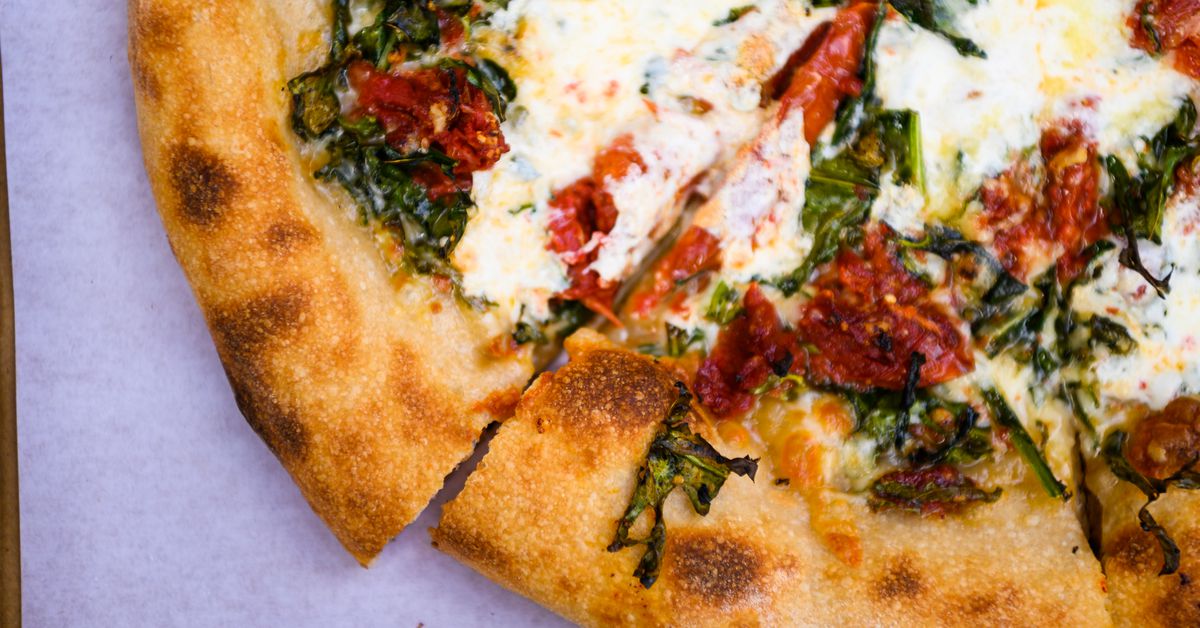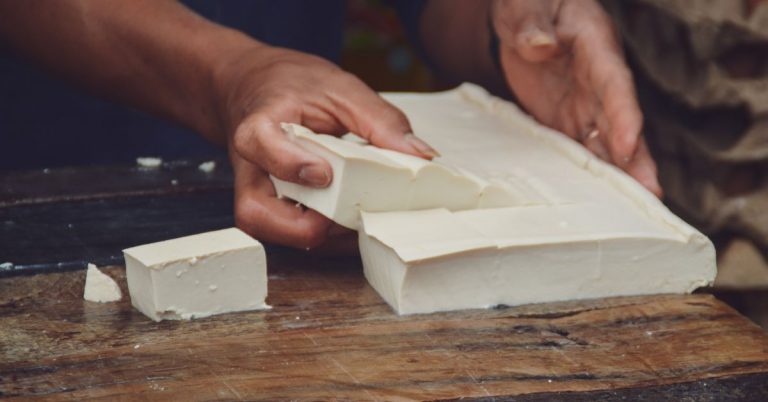How Camas Country Mill Became Portland’s Grain and Flour Rockstar
The dining room at Blue Hill at Stone Barns, with its linen-lined tables and suit-wearing servers, is, at the end of the day, a barn. But Dan Barber’s influential Westchester County farm and restaurant is unlike many other farms in the country. And surrounded by well-dressed Westchester well-to-dos and Manhattan commuters sitting down to a five-hour lunch, Oregon farmer and miller Tom Hunton felt a little out of place.
“We’re surrounded by all these New Yorkers, and here we get the preferred table by the kitchen,” he says. “Dan Barber checks in on us.” Barber had invited Tom and Sue Hunton to lunch, a thank-you for providing the restaurant with their Edison wheat seeds for his farm and bread program. The Huntons own Camas Country Mill, which supplies many of Oregon’s best bakeries, pizzerias, and restaurants with its prized, stone-milled flours; those flours are often made with hard-to-find grains grown in and around Eugene.
Portland chefs name-drop Camas Country on their menus; bakeries strategically place bags of Edison hard white flour or hard red spring near the window, visible from the order counter. The Huntons’ flours appear in Tabor Bread’s single-grain loaves, kneaded into the pizza dough at Lovely’s Fifty Fifty and Nostrana, and baked into croissants at Seastar Bakery; even Freeland uses Camas Country Mill’s barley and rye in its whiskey. In many ways, Camas Country is the through-line between Portland’s celebrated baking and pizza scenes, the home-state flour behind some of the city’s glutinous giants.
But Camas Country isn’t just an Oregon flour darling; its wide variety of grains, stone-milling process, and family business charm have caught the attention of some of the country’s biggest bread nerds, from Tartine’s Chad Robertson to the team at Washington State University’s Breadlab. At Stone Barns, the Camas Country wheat bread came out on a plate alongside a flight of “single-udder butter,” which is exactly what it sounds like. “Three versions of single-udder butter,” Tom Hunton says, with a chuckle. “On the way home, we were thinking, ‘How many farmer kids grew up on single-udder butter without spending $300 on it?’ People there pay good money for the experience that kids have growing up here.”
The Huntons appreciate the cross-country conversation around their flour, but for them, much of the appeal of growing these grains and stone-milling them comes from a health and community perspective. Camas Country Mill isn’t just sending its products to prestigious bakeries and restaurants; it’s sending its products to schools and food banks. “We think the commercial side helps us fund the humanitarian work,” Tom Hunton says.
“That’s the goal,” Sue Hunton says, “to stop getting everything off the Sysco truck… to stop relying on commercial food.”
:no_upscale()/cdn.vox-cdn.com/uploads/chorus_asset/file/23116126/20211022_MollyJSmith_Eater_Lovelys5050_CamasCountryMill.005.jpg)
:no_upscale()/cdn.vox-cdn.com/uploads/chorus_asset/file/23116121/20211022_MollyJSmith_Eater_Lovelys5050_CamasCountryMill.003.jpg)
Tom Hunton was raised by farmers, but he didn’t know he would one day be selling artisan flours to some of the state’s best bakers and chefs. His family farm in Junction City primarily grew nonfood crops like clover seeds and turf grasses; he expected that he, too, would grow those sorts of things for the rest of his life.
In 2008, when the economy was tanking, Hunton began to consider what it would look like to grow a wider swath of grains; the farm already grew soft white wheat for export, but they wanted to expand their offerings, focusing on the local market. They started with hard red spring wheat and teff, the Ethiopian grain crucial to dishes like injera, hauling it to the Butte Creek Mill in Eagle Point. Once news got out about the Hunton family’s teff, Ethiopian markets and distributors around the country began reaching out, placing orders. Working with agricultural scientists at Oregon State University, Washington State University, the University of California, and the Southern Willamette Valley Bean and Grain Project, Hunton began planting more and more grains — hard white spring, rye, and other flours often used for bread.
“People kept saying, ‘You can’t grow [grain for] bread flour here,’ but if you look back 150 years, there were grist mills all over,” he says.
He’s right: In the mid-to-late 1800s Eugene, the millrace was the heart of the economy, powering both saw and flour mills for the larger region. However, as homes went up along the water, the mills fell by the wayside, and people began to focus on the larger agricultural value of the area. The lengthy growing season and numerous farmers powered Oregon’s local food movement; chefs and groceries coveted Willamette Valley produce, Painted Hills beef, Springfield Creamery dairy.
But that same attention wasn’t paid to where we sourced our grain. Before Camas Country Mill, there were two main games in the Pacific Northwest when it came to high-quality, locally produced flour: Shepherd’s Grain, a farmer-owned company that focused on sustainability in the field, and Bob’s Red Mill, which makes one of the country’s most widely available stone-milled flours. In 2011, 85 percent of the wheat grown in Oregon was exported out of the country; local farmers supplying local mills with flour for local bakeries was still a pretty rare occurrence in Oregon then. It was difficult to find single-grain flours anywhere, and if those flours were available, they weren’t necessarily stone-milled — plus, it was harder to figure out when, exactly, those flours came out of the mill and into a bag.
Most wheat and grains grow in the middle of the country: the Dakotas, Kansas, Montana. The vast majority of those end up getting milled with roller mills, which separate the endosperm from the bran and the germ. Think of a grain of wheat as an egg: The bran is the shell, the endosperm is the egg white, and the germ is the yolk. When flour producers just use the endosperm, as they do with white flour, it loses much of its flavor and nutritional value — vitamins, minerals, fiber, protein. Many commercial flour producers add back those vitamins and nutrients toward the end of the process; that’s what makes those flours “enriched.”
Stone mills, on the other hand, don’t separate the endosperm from the germ and bran; they slowly churn the grains into smaller and smaller pieces until it becomes something like flour. That’s what we think of as “whole grain” flour — you get all of the elements of the grain, including all of the vitamins, protein, and fiber. The bad news: It spoils fast, which gives it that flavor that turned the kids of hippies off whole-grain pastries.
“[Whole wheat flour] was really ruined in the ’60s and ’70s — it was going rancid in people’s pantries, so the flavor people associate with whole wheat flour, it’s the taste of rancid flour,” says Sarah Minnick, the owner of nationally renowned pizzeria Lovely’s Fifty Fifty. To avoid that rancid, patchouli-mom’s-bran-muffin flavor, bakers and pizzaiolos like Minnick need access to locally grown, locally milled flour, so they can get their hands on it while it’s still fresh.
As the Huntons were starting to expand, they were thinking about how they could find their own little nook in the market. “We realized without a mill, we were still in the commodity business,” Tom Hunton says. So, for the first time in almost 80 years, the Huntons fired up a stone grist mill in Eugene, feeding it grains from the family’s Junction City farm.
Isabel Cortez bags product for Mainstay Malt at Camas Country Mill.
Right as the Huntons opened Camas Country Mill, bakers in Portland were getting more interested in stone-ground grains and whole wheat flours — and the country was watching. Kim Boyce opened her groundbreaking whole wheat bakery, Bakeshop, in 2012, hot off the success of her 2010 whole wheat baking book, Good to the Grain. Another celebrated Portland baker, Ken Forkish, had something of the opposite trajectory: His bakery, which opened in 2001, ushered in more interest in Oregon’s bread scene; by 2012, his baking book, Flour Water Salt Yeast, was hitting shelves around the country. In it, Forkish talks at length about flour sourcing and the specific flour percentages best for certain breads. Both bakers ended up taking home James Beard Awards for their baking bibles.
But for Tabor Bread founder Tissa Stein, inspiration for her celebrated sourdough bakery didn’t come from a Portland name; she was a disciple of blacksmith baker Alan Scott. Scott was primarily known for his wood-burning ovens, which inspired home cooks and chefs to build backyard brick ovens for pizzas and sourdough. However, with Scott’s ovens came his bread-baking doctrine, a doctrine that Stein — his neighbor — took as gospel.
“He thought bread should be a very simple thing: whole grain, sourdough, and fresh flours. That’s it, that’s all you need,” she says. “So when I started my bakery, that’s what I used as a model.”
When she started planning to open Tabor Bread in Portland in 2012, she needed to find a local grain source, to fuel the stone mill she bought for her bakery. She and her initial baker, Corey Mast, began touring wheat fields and milling operations around Oregon and Washington, but they were charmed by Tom Hunton — who had just finished building his stone mill. “Camas stood out to us, and Tom is just a prince,” Stein says. “I feel like we kind of grew up together in a certain way.”
As more up-and-coming bakers and other dough-slingers began opening shops in Portland, the demand for high-quality, whole-grain flour rose; Tabor Bread, Grand Central Bakery, Bakeshop, and Ken’s Artisan Bakery all began using Camas Country Mill flour, and other pastry chefs and bakers started to notice. Over time, chefs and bakers began seeking out Camas Country Mill products, asking for high-protein flours for pizza dough, rye flour for bagels, durum for pasta.
Minnick, at Lovely’s Fifty Fifty, has been buying Camas Country Mill for 10 years, using a blend of spelt, hard red spring, and Edison wheat in her pizza dough. For her, the health benefits are just a bonus — using high-quality fresh flours gives her pizza a more interesting flavor and texture, nuttiness, and crunch. “People say, ‘Grains are trendy,’ and people say ‘I think it’s cool to use old grains,’” Minnick says. “But also, we use them because they’re delicious. I think that’s the thing people are missing.”
Eventually, requests came in for grains the Huntons couldn’t grow; instead, they began to source from other small farms in the area, diversifying their offerings. Today, Camas Country Mill sources and grows dozens of grains, seeds, legumes, and cereals for its mill, things like red fife, teff, millet, einkorn berries, red flint, and spelt flakes. It also offers more chef or baker-oriented flours — blends for pizza, and a few varieties of bread flours.
“We focused on the niche of what the bakers and pizza jerks want,” he says. Within a few years, Camas Country Mill became synonymous with the city’s best doughs.
Bags of Floriani red flint cornmeal are ready to be picked up at Camas Country Mill.
On a Friday morning in October, Tom Hunton woke up early, loaded up his truck with heavy bags of flour, and drove the two hours north of Eugene to Tabor Bread’s bakery on Southeast Hawthorne. Stein regularly orders bags of Artisan red winter wheat flour, einkorn, spelt, and rye, which become the sought-after loaves of single-varietal bread that rotate day to day. After chatting with Stein a bit, he headed west to Little T Baker, then to commercial noodle company Shin Shin, and then swung by Nostrana, Pizza Thief, and Handsome Pizza. When his truck bed was empty, he headed south to the mill, tucked away on a nondescript corner of west Eugene.
Even considering the company’s rapid growth, it’s still a small family business: Tom’s son now runs the family farm; Sue’s daughter manages the office. Tom’s 98-year-old mother still manages the farm’s books. Camas Country Mill has a whopping 14 people on payroll, and the business still hand-packages and hand-weighs its flour. And Tom still drives his flour up to Portland, week after week. “Obviously, Portland is a cool food scene,” he says. “We never knew these people when we started doing this. When you start in production, supplying a faceless consumer, and transition to growing food so that you can eat and share it with people, that’s so rewarding.”
The Huntons don’t eat up in Portland extremely often; they’ve been to Nostrana (another client) and Lovely’s (“Sarah is a queen of pizza,” Tom says), but when Tom thinks about his meals in Portland, he remembers a particular dinner at Tastebud in Southwest Portland that centered around peach-prosciutto pizza. (“How do you think of that?”)
For the Huntons, bakeries and restaurants are just a part of the larger story of Camas Country Mill. Sue Hunton worked as a sixth-grade teacher for years, and since the early days of their relationship, she has been advocating for the use of whole grains in schools. One of the first clients of Camas Country Mill was the Bethel School District, which would buy Edison wheat for its cafeteria; now, 10 Oregon school districts use Camas Country Mill whole-grain flour. Before the pandemic, the Huntons would host field trips on the farm, showing kids how grain becomes flour, and sending them home with a bag of flour and apple carrot muffin made with Edison wheat. “It’s about changing the palates of the kids,” she says. “We want to showcase — this is what it looks like to build a cinnamon roll with hard red flour, this is a cookie made with teff. At the bakery, I saw this 5-year-old with a snickerdoodle, and I said, ‘How’s your cookie?’ He said, eyes wide, ‘Amazing.’ That’s what it’s about.”
The company now has its own line of pastas and muffin mix, a Junction City bakery, and a strong network of regional farms. The Huntons have helped other millers and farmers launch their own projects, including Cairnspring Mills in Burlington, Washington. They’ve purchased and restored a historic schoolhouse for community events and weddings, including a summer pioneer camp for kids. That’s the main driver for the Huntons — not culinary prestige, but community trust.
“The pastor who married us, he asked us to bring wheatberries to [the] service,” Tom Hunton says. “Sue baked a hearth bread, and they used it for communion. They wanted bread from someone they knew.”
It turns out, most of us do.






